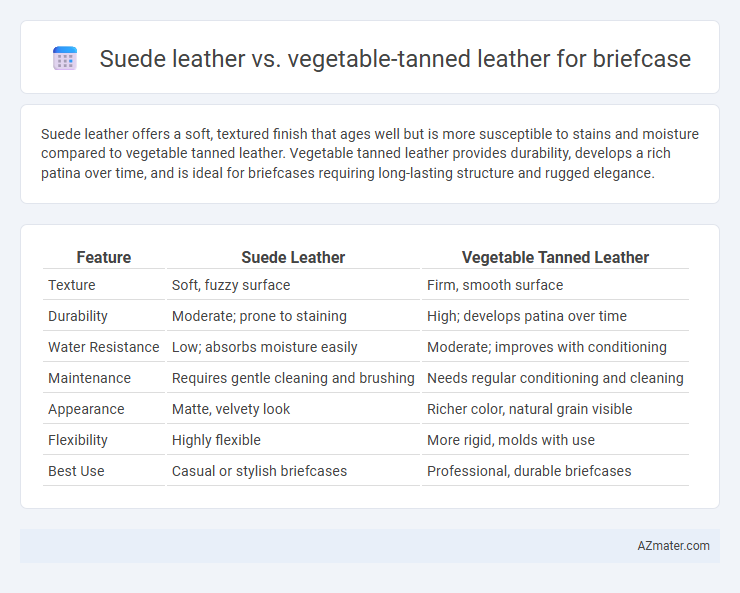Suede leather offers a soft, textured finish that ages well but is more susceptible to stains and moisture compared to vegetable tanned leather. Vegetable tanned leather provides durability, develops a rich patina over time, and is ideal for briefcases requiring long-lasting structure and rugged elegance.
Table of Comparison
| Feature | Suede Leather | Vegetable Tanned Leather |
|---|---|---|
| Texture | Soft, fuzzy surface | Firm, smooth surface |
| Durability | Moderate; prone to staining | High; develops patina over time |
| Water Resistance | Low; absorbs moisture easily | Moderate; improves with conditioning |
| Maintenance | Requires gentle cleaning and brushing | Needs regular conditioning and cleaning |
| Appearance | Matte, velvety look | Richer color, natural grain visible |
| Flexibility | Highly flexible | More rigid, molds with use |
| Best Use | Casual or stylish briefcases | Professional, durable briefcases |
Introduction to Leather Types for Briefcases
Suede leather offers a soft, textured finish with a casual, matte look that suits stylish and lightweight briefcases, while vegetable tanned leather provides a durable, firm structure with natural aging and rich patina ideal for professional, long-lasting briefcases. Vegetable tanning involves natural tannins from tree bark and plants, resulting in environmentally friendly, sturdy leather that molds well over time. Suede, created by sanding the inner split of the hide, offers breathability and flexibility but requires more care to maintain its appearance and resist moisture.
What is Suede Leather?
Suede leather, derived from the underside of animal hides, features a soft, napped finish that offers a velvety texture and elegant appearance ideal for briefcases. Unlike vegetable tanned leather, which is treated with natural tannins to develop firmness and durability, suede provides a more flexible and lightweight option but is less resistant to moisture and wear. Its porous surface enhances grip and aesthetic appeal, making it a popular choice for stylish, casual briefcases requiring careful maintenance.
What is Vegetable Tanned Leather?
Vegetable tanned leather is made using natural tannins from tree bark, leaves, and other plant materials, resulting in a durable and eco-friendly material ideal for high-quality briefcases. Compared to suede leather, which has a soft, napped finish, vegetable tanned leather offers a firmer structure, develops a rich patina over time, and provides better resistance to wear and aging. Its natural tanning process enhances the leather's strength and longevity, making it a preferred choice for professional briefcases that require both style and durability.
Appearance and Texture Comparison
Suede leather features a soft, napped surface that offers a velvety texture and a casual, matte finish ideal for stylish, relaxed briefcases. Vegetable tanned leather boasts a smooth, firm texture with a natural, rich patina that deepens over time, providing a classic and polished appearance. Suede's porous surface requires more maintenance to resist stains, while vegetable tanned leather is more durable and develops character with age.
Durability and Longevity
Suede leather, made from the underside of the hide, offers a soft texture but generally shows wear and stains more easily, impacting its durability for briefcases subjected to daily use. Vegetable tanned leather, treated with natural tannins, provides superior longevity and develops a rich patina over time, making it more resistant to scratches and environmental damage. For briefcases requiring robust durability and extended lifespan, vegetable tanned leather is the preferred choice.
Maintenance and Care Requirements
Suede leather requires regular brushing with a soft suede brush to remove dirt and prevent matting, along with prompt treatment of stains using specialized suede cleaners to maintain its delicate, napped texture. Vegetable tanned leather demands conditioning with natural oils or waxes to prevent drying and cracking, while avoiding excessive moisture exposure to preserve its firm structure and rich patina over time. Both materials benefit from storage in breathable dust bags to minimize environmental damage and extend the lifespan of a briefcase.
Environmental Impact and Sustainability
Suede leather production involves chrome tanning, which releases harmful chemicals affecting water systems, whereas vegetable tanned leather uses natural tannins from tree barks, making it more eco-friendly and biodegradable. Vegetable tanned leather typically has a longer lifespan and develops a rich patina, reducing environmental waste by extending product usability. Brands focusing on sustainability prefer vegetable tanned leather due to its lower carbon footprint and reduced chemical pollution compared to suede leather.
Weight and Flexibility Differences
Suede leather is typically lighter and more flexible than vegetable tanned leather, making it ideal for briefcases that require softness and ease of movement. Vegetable tanned leather, on the other hand, is denser and stiffer, providing greater durability and structure but adding more weight. Choosing between the two depends on whether you prioritize lightweight flexibility or robust support in a briefcase.
Cost and Value Considerations
Suede leather offers a softer texture and usually comes at a lower price point than vegetable tanned leather, making it appealing for budget-conscious buyers. Vegetable tanned leather commands a higher cost due to its durability, natural aging process, and eco-friendly tanning method that enhances value over time. Investing in vegetable tanned leather ensures long-term resilience and a unique patina that increases the briefcase's worth, while suede prioritizes affordability and aesthetic appeal.
Which Leather is Best for Your Briefcase?
Suede leather offers a soft, velvety texture and a casual, stylish look ideal for everyday use but requires more careful maintenance due to its susceptibility to stains and water damage. Vegetable tanned leather provides robust durability, develops a rich patina over time, and resists wear and tear, making it a practical choice for a long-lasting and professional briefcase. Choosing the best leather depends on balancing desired aesthetics and durability needs for your briefcase use.

Infographic: Suede leather vs Vegetable tanned leather for Briefcase
 azmater.com
azmater.com